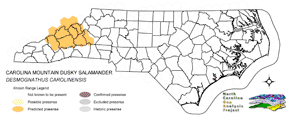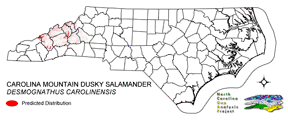|
| | | | | | | | | | |
 |
| |
|
Carolina mountain dusky salamander
|
|
| Desmognathus carolinensis
|
| |
| ITIS Species Code: 550253
NatureServ Element Code: AAAAD03130
|
|
| |
| |
Amphibia | | Caudata | | Plethodontidae
|
| | NatureServe Global Rank: | |
NatureServe State (NC) Rank: | | |
| | | Federal Status: | |
NC State Status: | | |
| |
|
|
|
| |
| HEXAGONAL KNOWN RANGE: | PREDICTED DISTRIBUTION: |
 |  |
|
|
|
| |
| SUMMARY OF STATEWIDE PREDICTED DISTRIBUTION: |
| | | | Land Unit |
| | US Fish & Wildlife Service | | US Forest Service | | US National Park Service
| | US Department of Defense | | NC State Parks | |
NC University System | | NC Wildlife Res. Com. | | NC Forest Service | |
NC Div. of Coastal Mgmt. | | Local Governments | | Non-Governmental Org. | |
Other Public Lands | | Private Lands |
| | GAP Status 1-2
| | All Protected Lands | | Statewide |
|
| | | Hectares |
| |
0.00 | | 24,307.47 | | 0.00 | |
14,644.98 | | 746.73 | | 0.00 | |
731.43 | | 0.00 | | 0.00 | |
2,214.36 | | 2,029.86 | | 0.00 | |
60,086.70 |
| | 21,313.71 | | 44,595.18
| | 104,761.53
| | | | | Acres |
| |
0.00 | | 60,065.05 | | 0.00 | |
36,188.53 | | 1,845.21 | | 0.00 | |
1,807.40 | | 0.00 | | 0.00 | |
5,471.80 | | 5,015.89 | | 0.00 | |
148,477.44 |
| | 52,667.31 | | 110,197.07
| | 258,871.33
|
| | % of Dist. on |
| Prot. Lands |
| |
0.0 % | | 54.5 % | |
0.0 % | | 32.8 % | |
1.7 % | | 0.0 % | |
1.6 % | | 0.0 % | |
0.0 % | | 4.4 % | |
4.4 % | | 0.0 % | |
0.0 % |
| | 47.8
% | | ----- | | ----- |
|
| % of Dist. on | | All Lands |
| |
0.0 % | | 23.2 % | |
0.0 % | | 14.0 % | |
0.7 % | | 0.0 % | |
0.7 % | | 0.0 % | |
0.0 % | | 2.1 % | |
1.9 % | | 0.0 % | |
57.4 % |
| | 20.3
% | | ----- | | ----- |
|
|
|
|
|
|
|
|
|
|
| |
| HABITAT DESCRIPTION: |
| |
The distribution of this species is restricted to a few mountain ranges in the southern Appalachians, including the Unaka, Black, Bald, and Blue Ridge mountains in North Carolina (Petranka 1998). Found from high peaks down to most mountain valleys within its range (King 1939). This salamander is very common in a variety of moist to saturated mountain
habitats (Huheey and Stupka 1967). It can be found on wet rockfaces, in seepages, and among leaf litter and debris on the forest floor in and near streams (Petranka 1998). Populations below ~4500 ft are concentrated near streams and seeps whereas populations above are more evenly distributed on the forest floor. Eggs are laid in moss or leaves very
close to streams (King 1939). Larvae are aquatic. NATURE SERVE GLOBAL HABITAT COMMENTS: At lower elevations and in winter usually concentrates near seepage areas, springs, and small streams; may range into adjacent wooded areas in wet weather. More terrestrial at higher elevations, characteristic inhabitant of floor of spruce-fir forests.
Often abundant on wet rock faces. Eggs are laid in wet rock crevices or under rocks, logs, or moss in seepage areas or near small streams.
|
|
| |
| MODELING DESCRIPTION: |
| Occupied Landcover Map Units: |
| | Code |
Name | Description |
NC Natural Heritage Program Equivalent |
| 230 | Piedmont Mesic Forest
|
American Beech - Red Oak - White Oak Forests.
|
Mesic Mixed Hardwood
|
| 384 | Piedmont/Mountain Mixed Bottomland Hardwood Forests
|
Includes temporarily to seasonally forests dominated by hardwood species. Hardwoods include sweetgum, red maple, sycamore which co-occur in a mosaic of bottomland and levee positions. Includes alluvial hardwood forests in the mountains. Hemlock and
white pine may occur as inclusions, but are generally mapped separately.
|
Piedmont/Mountain Alluvial Forest, Piedmont/Mountain Levee Forest
|
| 228 | Piedmont Dry-Mesic Oak and Hardwood Forests
|
Primarily oak dominated forests, white oak is often dominant, with co-dominants including . Also represented by sweetgum and tulip poplar dominated forests.
|
Dry Mesic Oak Hickory Forest, Basic Oak Hickory Forest, Dry Oak Hickory Forest
|
| 517 | Hemlock Floodplain Forest
|
Alluvial forest with hemlock and/or white pine in mountains and western piedmont. Hydrology is generally temporarily to seasonally flooded.
|
Canada Hemlock Forest
|
| 521 | Spruce/Fir Forest
|
High Elevation Frazer-Fir - Red Spruce, Red Spruce and Red-Spruce-Yellow Birch Forests. Tree densities included here include both woodland to forest density. Highly intermixed with Northern Hardwoods, Grassy Balds, and Shrub Balds.
|
Red Spruce--Fraser Fir Forest, Fraser Fir Forest
|
| 522 | Northern Hardwoods
|
High Elevation forests including yellow birch, American beech, and yellow buckeye. Includes forests with Hemlock and Yellow Birch.
|
Northern Hardwoods Forest, Boulderfield Forest
|
| 525 | Appalachian Oak Forest
|
A variety of oak forest types including Black, White, Scarlet Oaks in dry to mesic situations. Includes forests historically co-dominated by American Chestnut.
|
High Elevation Red Oak Forest, Montane White Oak Forest
|
| 526 | Appalachian Cove Forest
|
Mixed Mesophytic forests of the mountains. Includes tuliptree, basswood, yellow buckeye and surgar maple. This class is mapped to include cove forests dominated or co-dominated by hemlock.
|
Rich Cove Forest, Acidic Cove Forest
|
| 527 | Appalachian Hemlock
|
Upland hemlock forests of the moutains region. Vary from side slopes to steep slope positions.
|
Canada Hemlock Forest
|
| 533 | Appalachian Swamp Forest
|
Evergreen and deciduous forests with saturated hydrologies. This class may contain a variety of trees species, including hemlock - red maple, pitch pine, and white pine forests.
|
Swamp Forest-Bog Complex, Southern Appalachian Bog, Southern Appalachian Fen
|
| 534 | Appalachian Wet Shrubland/ Herbaceous
|
Saturated shrubs and herbaceous vegetation. Often mapped as an inclusion in Appalachian Swamp Forest.
|
Southern Appalachian Bog, Southern Appalachian Fen
|
|
| View Entire Landcover Legend |
| |
|
Additional Spatial Constraints: |
| Exclude all area outside of known range. |
| Below 4,500 feet, exclude all land greater than 50 meters from an open water feature. |
| |
| CITATIONS: |
|
Petranka, J. W. 1998. Salamanders of the United States and Canada. Washington DC: Smithsonian Inst. Press.
Huheey, J. E., and A. Stupka. 1967. Amphibians and reptiles of Great Smoky Mountains National Park. Univ. Tennessee Press, Knoxville. ix + 98 pp.
|
|
|
| 10 March 2005 |
| |
This data was compiled and/or developed
by the North Carolina GAP Analysis Project.
For more information please contact them at:
NC-GAP Analysis Project
Dept. of Zoology, NCSU
Campus Box 7617
Raleigh, NC 27695-7617
(919) 513-2853
www.basic.ncsu.edu/ncgap |


